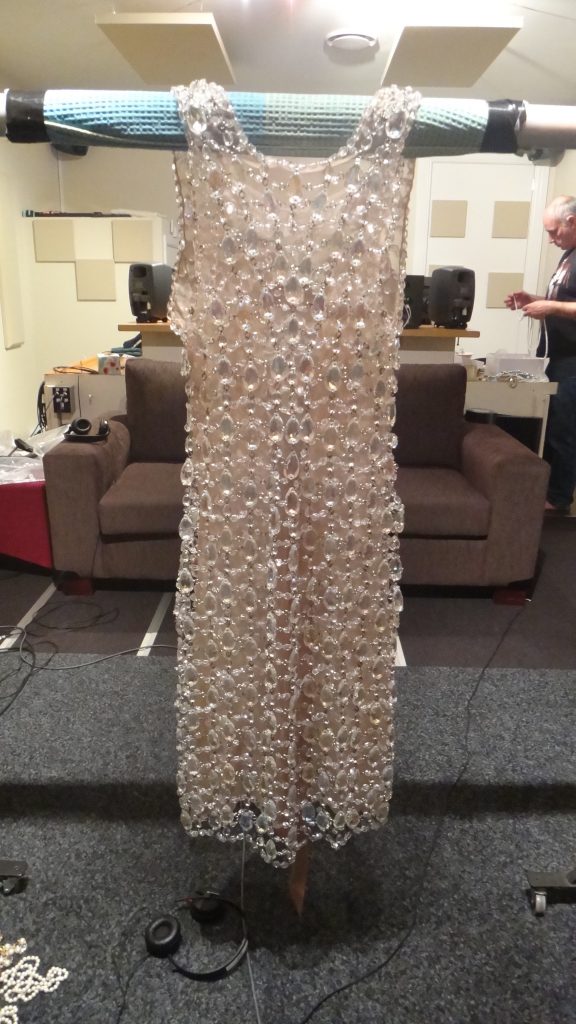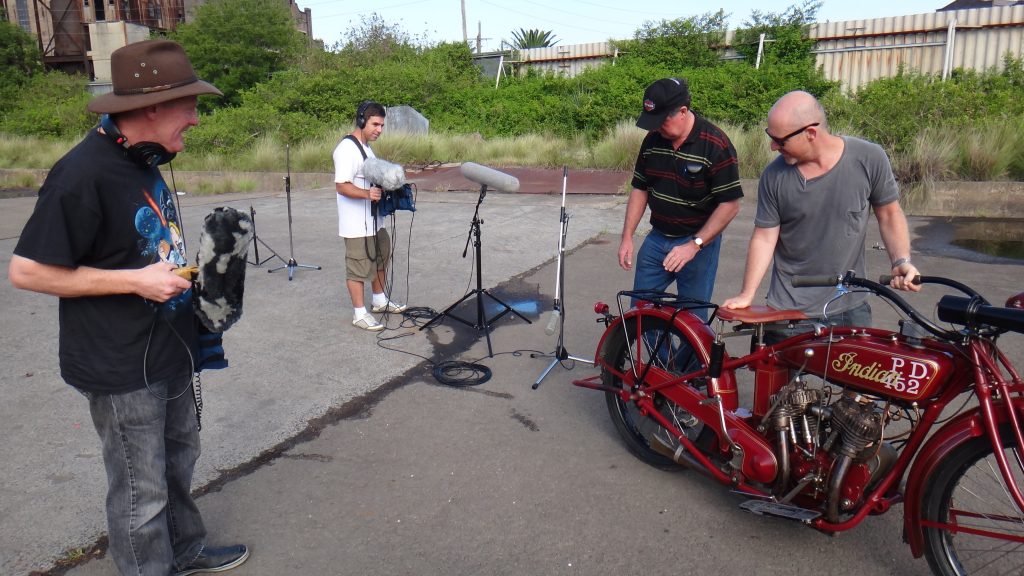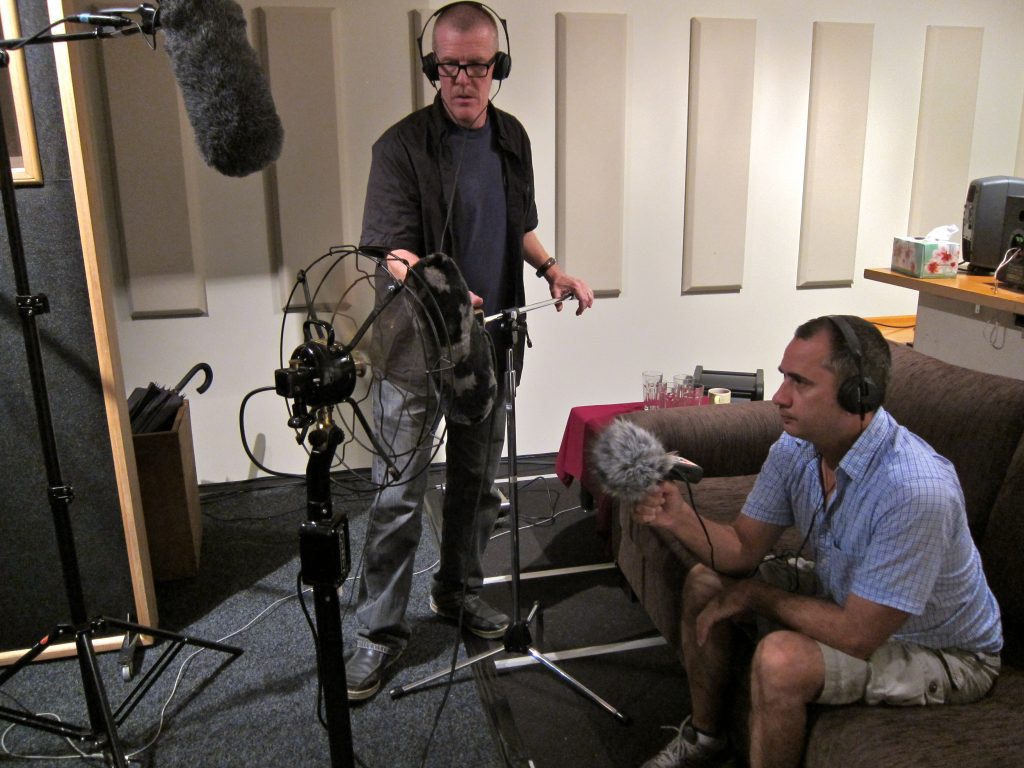Guest Contribution by Abigail Sie

The Great Gatsby was an unusually long sound post-production process. How long did the sound mix take?
Just under three months, it was quite a long haul. A lot of that really was logistics in the way of rethinking, re-conforming the pre-dubs and integrating new material with the edit as the picture changed and was updated throughout the final mix period.
Is that because of the visual effects?
A lot of it was due to VFX. Baz (Luhrmann) coined a phrase, which was part of the whole visual experience in 3D, called “Poetic Glue”. The “Poetic Glue” was a way of combining Fitzgerald’s poetry and making it modern. It was the way flashbacks were used, transferring between time zones. Plus there was a lot of written word on the screen, which was directly from the book. So with that came a changing visual experience. The sound effects and design tried to chase the pace and edit and visual design of the film as they were continually updating.
Plus the music was still coming in. There were a lot of artists involved. People like Will.I.Am and Fergie and Jay Z deliver at their own pace. I wouldn’t call it a delayed release, I would just call it a build upon the vision that Warner Brothers embraced, because they knew they had something quite special in their hands.
Seeing as this was a really heavily conformed post-production process, are there any new ways or methodologies or ideas you’d want to share with people?
There were no new tricks really, except we used Conformalizer (a program by Justin Webster) and it worked brilliantly well.
But basically I have to hand it to the sound crew supporting the mix, because they got so good at it. We could turn around a 20-minute spool in roughly a day, give or take the number of changes. Besides the re-conforming, there were surprises from updated visual FX. Suddenly we would see a steam train passing through an environment. So it got track laid and we’d hit the mixing stage (Stage One at Deluxe) by 5:30 that afternoon. We’d conform the Neve and we would mix the new sound FX in live, no pre-dub first, and we’d be done by 8:00pm. So that’s how fast we were able to pull it together. We are only talking about three dialogue, three effects and two assistants. That went on for three months.
How did you approach the overall sound design of this film?
The directive from Baz was quite simple but very potent. It was, Protect Fitzgerald.
Basically there were two authentic approaches as described in the book. One was the truth of New York back in 1922, which was a progressive city, full of life, a city of construction. Buildings were going up faster than any other city in the world. Then there was the Long Island set which were the old rich; a sort of the palatial escape.

Dialogues were king, particularly in this case, you can’t afford to miss a word. Tom Buchanan, Daisy Buchanan, Myrtle Wilson, George Wilson – and with their dialogues came the embodiment of those words which is everything they’d wear. The costumes of the women, the jewellery, cigarette lighters, etc. were all recorded as sound effects, quite separate to the foley, which gave them a sense of great focus in terms of Nick Carraway’s point of view. I want to do a spoiler alert here because Baz has taken the fact the book is written in the first person and done an interesting visual device that allows the audience to experience Nick Carraway‘s subjective point of view of the world. Sound had to support that.

As the film is set in the mid 1920’s, were there any other special recordings you had to do?
Yes, we recorded about 15 or so vintage vehicles, from Rolls Royces through to a hero vehicle in the film which is called the Duesenberg Straight 8. Now that car, our hero vehicle, is a very important prop in the film. I suppose you’d liken it to the DeLorean in Back to the Future. Warner Brothers actually bought two of them – but they were replicas and had V8s in them.
Baz, in his enthusiasm for attention to detail, wanted the original Straight 8 engine, which is similar to a Mac truck. And they just don’t exist in terms of already recorded sound FX.
There are only two places in the world that had these vehicles. One was in Indiana, in the United States, and the other is at Jay Leno’s garage, in Burbank in Los Angeles. Now Jay has great enthusiasm for vehicles. He’s poured a lot of money into his incredible, museum-like garage.
He actually has eight Duesenbergs, all of them restored to spec. He buys vehicles that are run down and falling to pieces from some dusty old garage. Then he gets the blueprints and re-machines the engines back to their original form.
This particular one we wanted was also supercharged. So we went to Jay Leno and he agreed to let us record it with a donation to one of his favorite charities. He actually spent the day with us. We ripped the car from head to toe, hooning around Bob Hope Airport.
So I just think it’s wonderful to have that sort of magic, that sort of degree of authenticity in gathering sounds for the film and the Duesenberg is one of them. This film probably has the only recording of that sort of vehicle in existence.
Jay Z executive produced the music used in the film. Can you talk about that?
Baz made an interesting call with music. He put himself in the position of Fitzgerald, back in 1922, when jazz was new. Louis Armstrong was just hitting his stride and all that big band material was very new. So with that same concept, he took what Gatsby would be experiencing today in modern music, and put it in this film.
The great thing he did though was not just throw in a Jay Z rap. He combined it with extraordinary material from the Bryan Ferry Jazz Orchestra. And now you got things like Take 5 and all those sorts of tunes back then, intermixed into Jay Z, Will.I.Am, Fergie, the XX and so on.
It’s a mash of styles that actually does relate to what was probably happening in 1922 in the way Fitzgerald would have seen it; that sort of new age of music and the excitement of it. It’s a great strength of the film.
What challenges were there mixing with this full-scale pop music?
Probably the biggest challenge was the use of voiceover against that sort of music. It’s Nick Carraway telling the story and no one is going to thank you if the voiceover is not heard.
And with so much voiceover it’s sometimes quite a compromise between where you feel you want to push the music and where to let the voiceover tell the story in a natural and smooth way. I hope we’ve succeeded there.
Did the music arrive in such a way that it was easy for you to control in the mix?
It depended on the artist that was delivering and their understanding of film in terms of stereo versus 5.1, things like that. That was probably the biggest deal for us, to make them understand that we needed the mono track so we could then segue into 5.1 on the vocals, for example. But let’s not also forget the score, which was written by Craig Armstrong, who worked with Baz on Moulin Rouge in the past. It’s absolutely sensational, and it really acted as subtext. Plus it was a joy mixing because the themes Craig wrote are so rich, yet had so much air in them that they never stepped on the dialogue.
How does the 3D finish affect the way you tracklay and mix?
No matter where you care to look, you’ll be able to find a little sound to match.
What was interesting with the mix is that we found, after we’d finished a reel and it was all feeling good in 2D, but we had to trim (adjust) the mix as soon as the 3D was put up.
It’s such a busy screen, in terms of Catherine Martin’s amazing production design, that the eye could easily wander over there when in fact you wanted them to look over here. So we used foley, to help focus the audience.
In 3D, you are looking into these vast expanses, of wealth and crowds or whatever. We found that we could really push the surrounds so much more, the environments, the atmospheres, actually lean on them, which helps envelop the audience into the world of the film.
Quite a lot of times we were pushing the strings in the music to the back as well. A lot of hard FX and hit points in music were raised, to kind of push you into the world. The production design in the 3D is extraordinary. It’s going to blow you away.
Apart from voiceover versus music being a particular audio challenge, were there any other difficult scenes for sound you’d like to talk about?
Yes, there’s an eight-minute sequence at the climax of the film where all of the main cast are together at The Plaza Hotel, and there’s a showdown between Jay Gatsby and Tom Buchanan over the love of Daisy. And in that scene, Baz always maintained there would be no music.
In the book, you’d also know that it’s set on the hottest day of the year. Each character had a fan blowing on them and porters were bringing in buckets of ice. That was probably the most challenging thing, to get the heat happening. It’s pretty hard to get heat happening without insects. We couldn’t put cicadas in there!
Basically, New York City and the fans in the room were used like score. We started by using the city and all it’s construction and making it musical – car horns, the construction of the Empire State Building, distant hammering and sirens.

Then we recorded all of the 1920 fans on each character and used the different tonal aspects of each, even down to the rattling of their blades and things like that, to increase the tension. Added to this was ADR, close up breathing, etc. All these things came together in the mix and then we would play it back and work out where the moments of tension needed to be heightened and where we should move away.
The performance of the cast is extraordinary. So I hope we’ve backed them up.
Can you talk about your mix crew on this film?
We had a wonderful mixing crew in Steve Maslow and Phil Heywood. Phil was on effects and Steve on dialogues and music. I’ve worked with Phil Heywood for over 15 years. And of course, I have worked with Steve before and knew he was one of the coolest guys on the planet, so I knew he and Baz would work together well.
Steve’s prowess in dialogue mixing, and particularly EQ, I’ve never seen anyone as good as that. But what he taught me, and I’m sure I speak for Phil as well, was his command of the room in a final mix situation. Maslow’s ease of politics is probably one of the greatest lessons I’ve learnt – to just keep it cool and know that it will be done. It was a great team and one I hope to work with again because they were so much fun and so easy to communicate with.
Anything else you’d like to add?
The team effort at Deluxe was just awesome. We had Angus Robertson leading the charge with Sam Hayward, Glenn Butler and Duncan McRae lending support to us and I can’t thank them enough nor express how much I value their brilliance.
Also, thanks to Warner Brothers as well who were a joy throughout the film. We were lucky enough to have the budget and the support from them to back up the whole sound post process. Plus, the inspiration from Baz as a leader is just extraordinary. We were all willing to go the extra mile because we knew we were working on something very special.
But my biggest thanks goes to the Great Gatsby sound editing team which included Fabian Sanjurjo, Jenny Ward, Derryn Pasquill, Rick Lisle, Mark Franken, Damian Candusso, Damon Mouris, Andrew Miller, Emma Mitchell, Will Ward & John Simpson. They did an awesome job and are truly a world-class bunch.
What’s next for you?
We’ve got a couple of things coming up and hopefully one of them will be another Warner Brothers production, so more on that to come.
Awesome
The sound in this movie was awesome. So subtle and detailed. It deserves to be up for an Oscar. Make a nice change from usual explosion fest!!
A fascinating interview. Provides many interesting insights into all the complexities involved in sound design and music. All the expertise from the team involved certainly greatly contributed to the amazing movie experience.
This is fantastic!!! Love the work this Wayne guy who clearly doesn’t get enough recognition does. I am going to watch all of his most recent pictures and am buying the first ticket to his upcoming movie, ‘The Lego Movie’